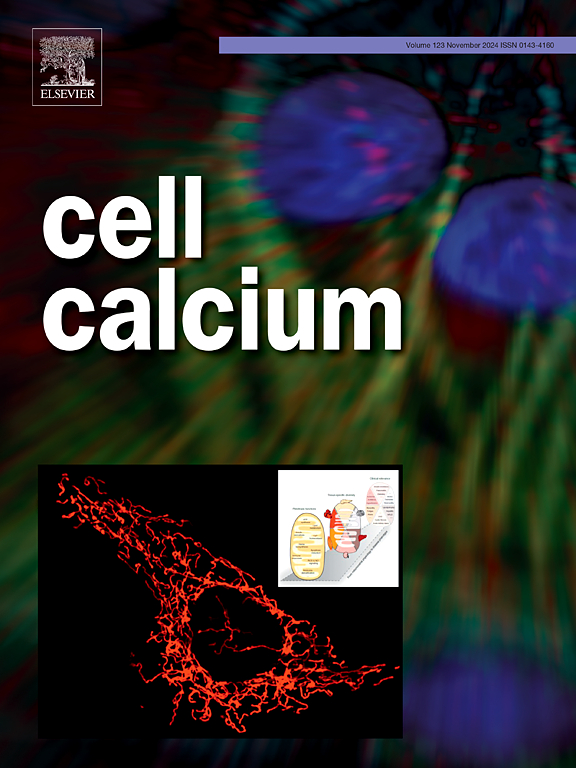在高血压大鼠中,H2S处理可恢复心脏肥厚并增加SERCA2a活性,但不能完全恢复心脏Ca2+处理
IF 4.3
2区 生物学
Q2 CELL BIOLOGY
引用次数: 0
摘要
硫化氢(H2S)已被提出发挥心脏保护作用,特别是由于它能够恢复左心室肥厚(LVH)和减轻各种心肌病(包括高血压心脏病)的心功能障碍。然而,H2S的心脏保护在多大程度上涉及Ca2+处理的改善仍不清楚。尽管有报道称H2S会影响关键Ca2+处理蛋白的功能,但大多数研究都集中在分离心肌细胞中急性给予H2S供体,而不是在治疗背景下。在这项研究中,我们使用腹主动脉缩窄(AAC)引起的高血压大鼠模型来评估H2S供体NaHS对LVH和Ca2+处理的治疗潜力。AAC治疗8周后,高血压大鼠出现中度LVH,伴有收缩Ca2+瞬态的幅度和上升速率降低,肌浆网(SR) Ca2+负荷降低。尽管降低了SR Ca2+负荷,舒张期Ca2+火花的频率仍然很高,而自发Ca2+波的发生率和传播率显著增加,表明舒张期SR Ca2+泄漏增强,很可能是由于ryanodine受体(RyR2)对Ca2+的超敏反应。另一方面,在AAC的最后4周给予NaHS可以恢复LVH和高血压,并增加SR Ca2+ atp酶(SERCA2a)介导的SR Ca2+再摄取。然而,NaHS治疗未能恢复收缩期Ca2+瞬态或SR Ca2+负荷的幅度和上升速度。此外,由于自发Ca2+波增加,SR Ca2+泄漏可能恶化。总之,NaHS治疗似乎并没有使高血压LVH期间的所有Ca2+处理特性正常化。相反,NaHS可能发挥致心律失常的作用,可能是由于在未解决的RyR2 Ca2+超敏状态下SERCA2a活性增强。本文章由计算机程序翻译,如有差异,请以英文原文为准。

H2S treatment reverts cardiac hypertrophy and increases SERCA2a activity but does not fully restore cardiac Ca2+ handling in hypertensive rats
Hydrogen sulfide (H2S) has been proposed to play a cardioprotective role, particularly due to its ability to revert left ventricular hypertrophy (LVH) and mitigate cardiac dysfunction in various cardiomyopathies, including hypertensive heart disease. However, the extent to which cardioprotection by H2S involves improvement in Ca2+ handling remains unclear. Although H2S has been reported to influence the function of key Ca2+ handling proteins, most studies have focused on acute administration of H2S donors in isolated cardiomyocytes, rather than in a therapeutic context. In this study, we used a rat model of hypertension induced by abdominal aortic coarctation (AAC) to evaluate the therapeutic potential of NaHS, an H2S donor, on LVH and Ca2+ handling. After 8 weeks of AAC, hypertensive rats developed moderate LVH, which was accompanied by a reduction in both the amplitude and the rate of rise of systolic Ca2+ transients, as well as a decrease in sarcoplasmic reticulum (SR) Ca2+ load. Despite the reduced SR Ca2+ load, the frequency of diastolic Ca2+ sparks remained high, while the incidence and propagation rate of spontaneous Ca2+ waves significantly increased, suggesting enhanced diastolic SR Ca2+ leak, most likely due to hypersensitivity of ryanodine receptors (RyR2) to Ca2+. On the other hand, NaHS administration during the final 4 weeks of AAC reverted both LVH and hypertension, and increased SR Ca2+ reuptake mediated by the SR Ca2+ ATPase (SERCA2a). However, NaHS treatment failed to restore the amplitude and rate of rise of systolic Ca2+ transients or SR Ca2+ load. Furthermore, SR Ca2+ leak might have worsened, since spontaneous Ca2+ waves increased. In conclusion, NaHS treatment does not appear to normalize all Ca2+ handling properties during hypertensive LVH. On the contrary, NaHS may exert an arrhythmogenic effect, likely due to enhanced SERCA2a activity under conditions of unresolved RyR2 Ca2+ hypersensitivity.
求助全文
通过发布文献求助,成功后即可免费获取论文全文。
去求助
来源期刊

Cell calcium
生物-细胞生物学
CiteScore
8.70
自引率
5.00%
发文量
115
审稿时长
35 days
期刊介绍:
Cell Calcium covers the field of calcium metabolism and signalling in living systems, from aspects including inorganic chemistry, physiology, molecular biology and pathology. Topic themes include:
Roles of calcium in regulating cellular events such as apoptosis, necrosis and organelle remodelling
Influence of calcium regulation in affecting health and disease outcomes
 求助内容:
求助内容: 应助结果提醒方式:
应助结果提醒方式:


